Share Tweet Download
My name is Joanna Vautour, I'm the Aboriginal Patient Navigator for the Toronto Regional Cancer Program.
I'd like to acknowledge the land and by acknowledging the caretakers of this land, this land has been and continues to be, the home and traditional territories of the Mississaugas of the New Credit, the Huron-Wendat and the Haudenosaunee. So as we think through relationships, it is critical that we also acknowledge Canada's settler, colonial and present history, and our own history on this land.
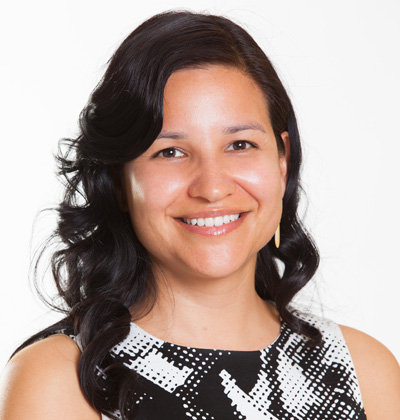
Joanna Vautour is the Aboriginal Patient Navigator at Princess Margaret Cancer Centre. Developed through Cancer Care Ontario’s Aboriginal Cancer Strategy, and housed at St. Michael’s Hospital, her role serves all the cancer centres in Toronto. (Photo: Joanna Vautour)
I have a unique role, where my office is based at St. Michael's Hospital and they provide me the position a home, but I support First Nations, Inuit and Metis patients with cancer at any of the care sites in the Toronto Region.
I'd really like to acknowledge the work of Cancer Care Ontario's Aboriginal Cancer Strategy. The role of the Aboriginal Patient Navigator, there's also roles for the regional aboriginal cancer leads and aboriginal program coordinators – these are direct actions from the Aboriginal cancer strategy.
I'm born and raised in Toronto. My mother – she's from Serpent River First Nation. And we are Anishinaabe and our family name is Meawasige. And my father is French-Canadian from the New Brunswick area.
Being raised in Toronto, my mother ensured that we were closely connected with our community back home.
My mother brought us every summer to spend time with our grandparents, and my grandparents were very kind and loving.
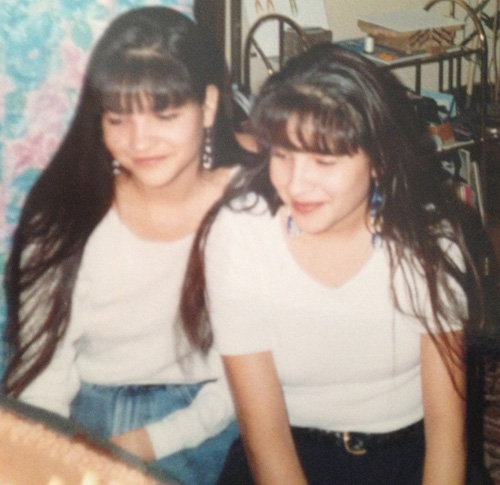
Joanna (on the left) and her twin sister, Julianna, celebrate their 16th birthdays. (Photo: Joanna Vautour)
My grandparents' home was a place of peace and security and love. And the front of their house, a painting of a thunderbird is there, which was well-known that Louis Meawasige and Alice Meawasige, that's their home. And that painting was done by my uncle, and the thunderbird represents my grandfather's spirit name, which is Thunderbird.
The sounds of the highway are very comforting to me, as well as the sounds of the train. It's located right on Highway 17, and for some people, they might be annoyed by those sounds, but for me they're very comforting.
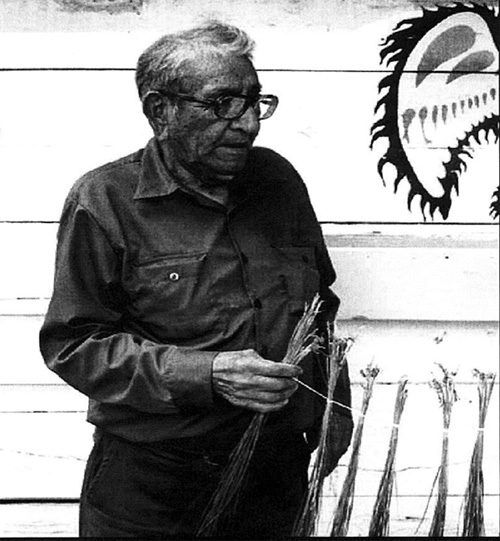
Joanna’s grandfather, Louis Meawasige with sweetgrass and Thunderbird at the back of their house in Serpent River First Nation. (Photo: Joanna Vautour)
My family has called this land home for forever.
Actually ten thousand, twenty thousand years before the celebration of Canada's 150th birthday.
For me, I see it as my ancestors walked this land and they're very much a part of me because they've been buried on this land. And as we walk on this land I feel very connected to them.
I respect others and what Canada has been support to them, and I understand that for newcomers, how this has been a welcoming home for them.
But this Canada is the first peoples' home but it hasn't always felt like home, because of the way we were made to feel and the policies that were enforced on us to not be able to speak our language, not be able to practice our cultural and spiritual practices.
And I think the ban was lifted in maybe 1961. Fifty-plus years later, and here I am, working in the hospital, and working with a number of different people to improve their understanding, or even help them start their understanding what are those practices and how can we respond to them.
What I would like to bring attention to is the truth and reconciliation commission of Canada calls to action. There are seven relating to health, number 18 to 24. And I always talk about Number 22. And that call to action is: We call upon those who can affect change within the Canadian healthcare system to recognize the value of Aboriginal healing practices and use them in the treatment of Aboriginal patients in collaboration with Aboriginal healers and elders requested by Aboriginal patients.
What I'm doing now is working with the University Health Network in a working group to develop a formal process to respond to a smudging ceremony. This involves lighting a plant medicine that we see as sacred and it creates a smoke.
Another ceremony that I talk a lot about is the sacred pipe ceremony. Recently, Ontario's smoke-free act has changed to include the use of tobacco for traditional aboriginal cultural or spiritual purposes.
Everyone has their own prayer, whether it's sitting down, maybe they need to be on the floor, it involves some movement. In our case, First Nations, it involves lighting something and creating a smoke. So we need to think about creating a space where we have the proper ventilation to accommodate that.
I see my role as being a bridge. Bringing in the traditional, cultural support between the patient and the healthcare team. I'm not only there to support the patient, but I'm also there to support the healthcare team.
I might be able to help them think about their approach with patients and it's different for everyone, as we know.
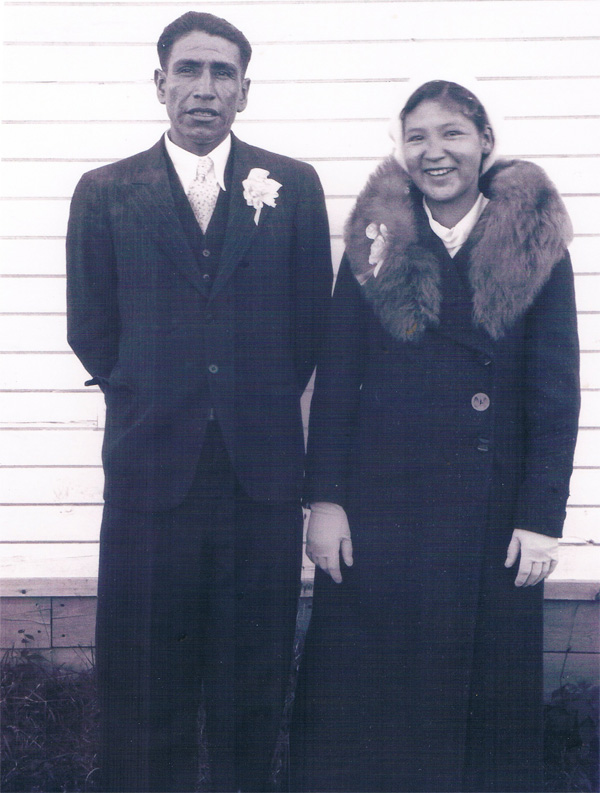
Joanna’s grandparents Louis Meawasige and Alice Meawasige on their Wedding Day. (Photo: Joanna Vautour)
One of the types of support that really touches my heart is the palliative and end-of-life care. there are times when I've been at the bedside with people and to hear their life stories. I do have moments where I get tearful, which I feel it coming on now. It's a true honour to be in that presence of the patient and family as they are in a moment that they will never forget, that they will always remember. There's a deep love during that time.
I describe my home as Serpent River First Nation, where my ancestors are from and where I truly feel connected. As soon I get there physically, or even if I take a moment to think about it, it brings peace.
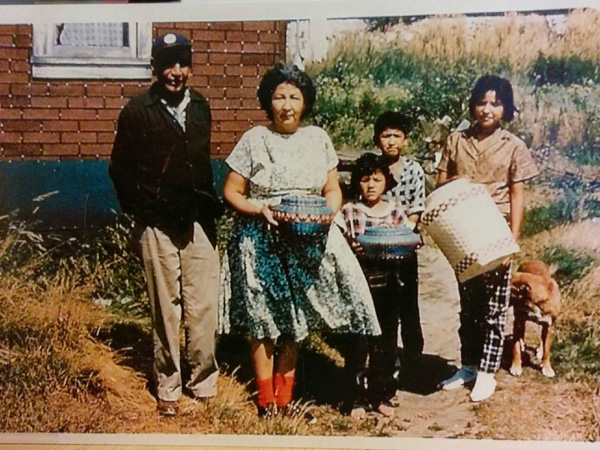
The Meawasige Family on Serpent River First Nation with Black Ash Baskets made by Joanna’s grandmother. Joanna’s grandparents are on the left, and her mother is on the far right, next to their dog Pal. (Photo: Joanna Vautour)
The feeling of peace brings the feeling of home. as I continue to build relationships at hospitals, I'm starting to feel like Princess Margaret is becoming my home, I feel that when I know my way around, I know which spaces I can go in and I will see someone I have a connection with, a relationship with, so I think it's peace and relationships that make your place a home.
In thinking about Canada's upcoming 150th celebrations, for me, I won't be celebrating. But it's brought me to a place to reflect on where we're at today in our relationships with the First Nations, Inuit and Metis people.
And what I would like people at UHN and in the healthcare field is to think about their relationships with the First Nations, Inuit and Metis people they serve, or their colleagues who might be First Nations, Inuit or Metis. And think about the legacy of the last 150 years and what that's been and what is the legacy that you want to be a part of moving forward.
When we look at reconciling relationships, I think that's something we can achieve now. What do we want to leave our children with? And I think let's make it a little easier for the future generations to come. We shouldn't have to struggle so much in our life.
